SEO for tourist operators is now a fundamental marketing strategy if you plan to have your tourism business be seen online. After all, if people can’t find you online or through Google Maps, do you even exist?
With the coronavirus affecting the travel and tourism industry, now may not be the best of times for expanding operations but rather to refocus your efforts on organic marketing such as SEO so that you will have an upper hand when business resumes. What’s even better is that SEO is free and anyone can do it. Want to know how? Read on.
WHAT IS SEO
SEO or Search Engine Optimisation is the process of increasing your website rank on search engines such as Google and Bing when your client searches for your services or products online.
For example, when a potential customer types in “Sydney tours” on Google search, if you have good SEO, your website will come up on top on Google search results.
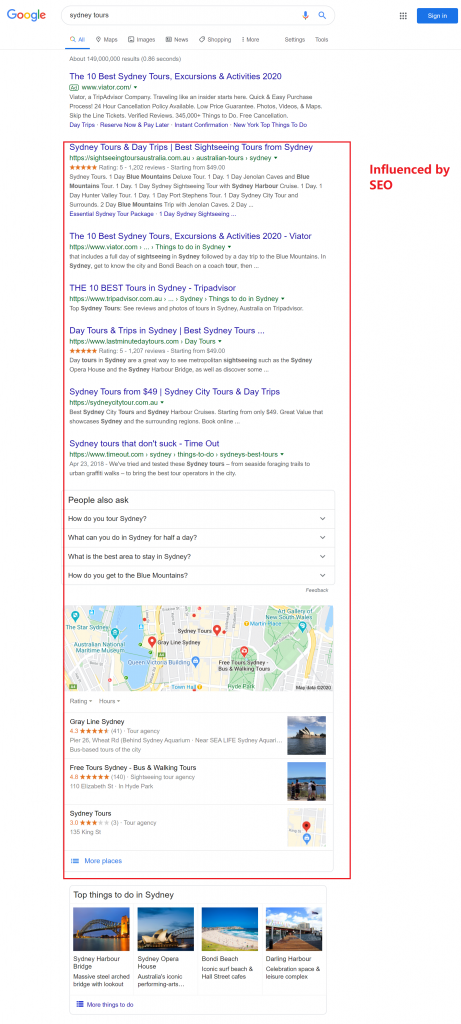
HOW IS SEO DIFFERENT FOR TOURIST OPERATORS
SEO for tourism and tourist operators take a slightly different approach to traditional SEO and focuses more on location or local SEO. This is because many tourist attractions are location based.
This means more emphasis is placed on keywords involving location, local SEO and finding your business on Google Maps for example when potential visitors search within the area.
Tourism Seo is also generally influenced by location. There’s only a certain number of tour operators within a certain city compared to the number of online computer retailers for example within a country. What does this all mean?
This means only a few operators will gain the majority of tourist business but only if they can be found online and resonate with their audience. This makes SEO especially important for tourist operators.
SEO TIPS FOR TOUR OPERATORS
LOCATION, LOCATION, LOCATION
Location is arguably the single most important search term when tourists search for things to do or see while on holidays.
To get the maximum benefits of SEO, you need to place location on the most important elements that affects SEO and they are:
- Page title
- Headings (H1, H2),
- Page URL or permalink
- Meta description
- Image alt text
- Image file name
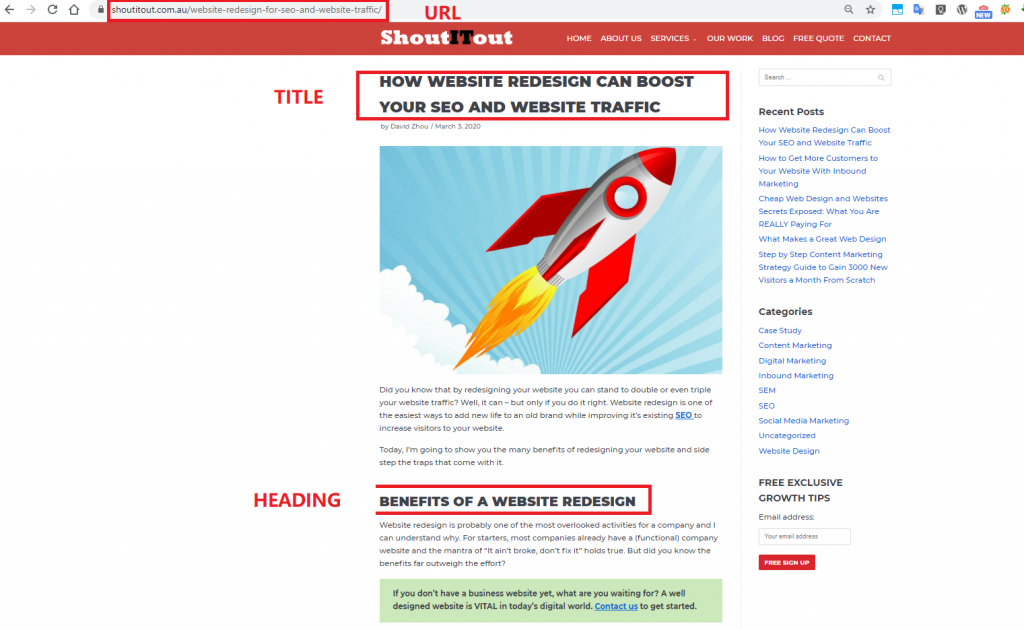

In order to get the maximum ranking exposure on search engines, set up a different page for each location service to increase your chances of ranking. This means, if you have tours in Sydney and Canberra, you need to set up two pages instead of combining them together even if they are in the same state or region.
NAP for Tourism Operators and Local Search Optimisation
NAP in SEO stands for Name, Address and Phone number. If your tour business wants to rank well for local organic SEO, then you must include consistent NAP in all relevant sources such as:
- Page Footer
- Contact Page
- Local directories
- Tourism directories
- Advertising and Marketing sources
- Google My Business profile
Google itself is quite good at detecting discrepancies. If your NAP on a directory doesn’t match the NAP on your website there could be a trust issue. So, ensure you have consistent NAP across all areas.
CONSISTENT NAP
We cannot emphasise the need for consistent NAP. If your NAP is not the same across all sources, it may lead to user frustration and may cost you a customer. This affects the usability of your website and business.
Common reasons for inconsistent NAP could be:
- A change of business name due to strategic decisions or mergers
- Different phone numbers for tracking purposes
- Relocation of office
Below are examples of inconsistent NAP we commonly spot:

How do you know if you have inconsistent NAP? An easy way is to do a Google search for your company and check all your contact details to see if they match. However, a more detailed audit may be required.
OPTIMISE GOOGLE MY BUSINESS
As mentioned previously, location is probably the most important aspect when optimising SEO for tourism operators. This means optimising Google My Business should be a main priority for your business.
WHAT IS GOOGLE MY BUSINESS
Google My Business lets you set up an online profile and listing on Google Search and Google Maps and allows your business to be seen when people search for you and your services online.
Google My Business comes with a few nifty features such as:
- Post photos of your business and its operations and culture
- Post articles online
- Allowing users to message and call you
- Allow users to set a waypoint on their Google Maps to visit you
- Link your website
- Add business hours
- Accept and manage user reviews
- Link social media to your business
- Advertise deals and link to your website
- Advertise products for sale
- Receive and send messages from your customers
Visit Google My Business to start setting up your free account if you don’t have one already.
WAYS TO OPTIMISE GOOGLE MY BUSINESS
Optimising Google My Business will allow local and location based searches to appear on the top 3 of Google maps of the search engine reports page.
This so-called Google Maps 3 Pack acts like a Google recommended list and has all the information a customer needs to contact them such as a call and directions button and also a direct link to their website . Can you imagine what this can do for your business?
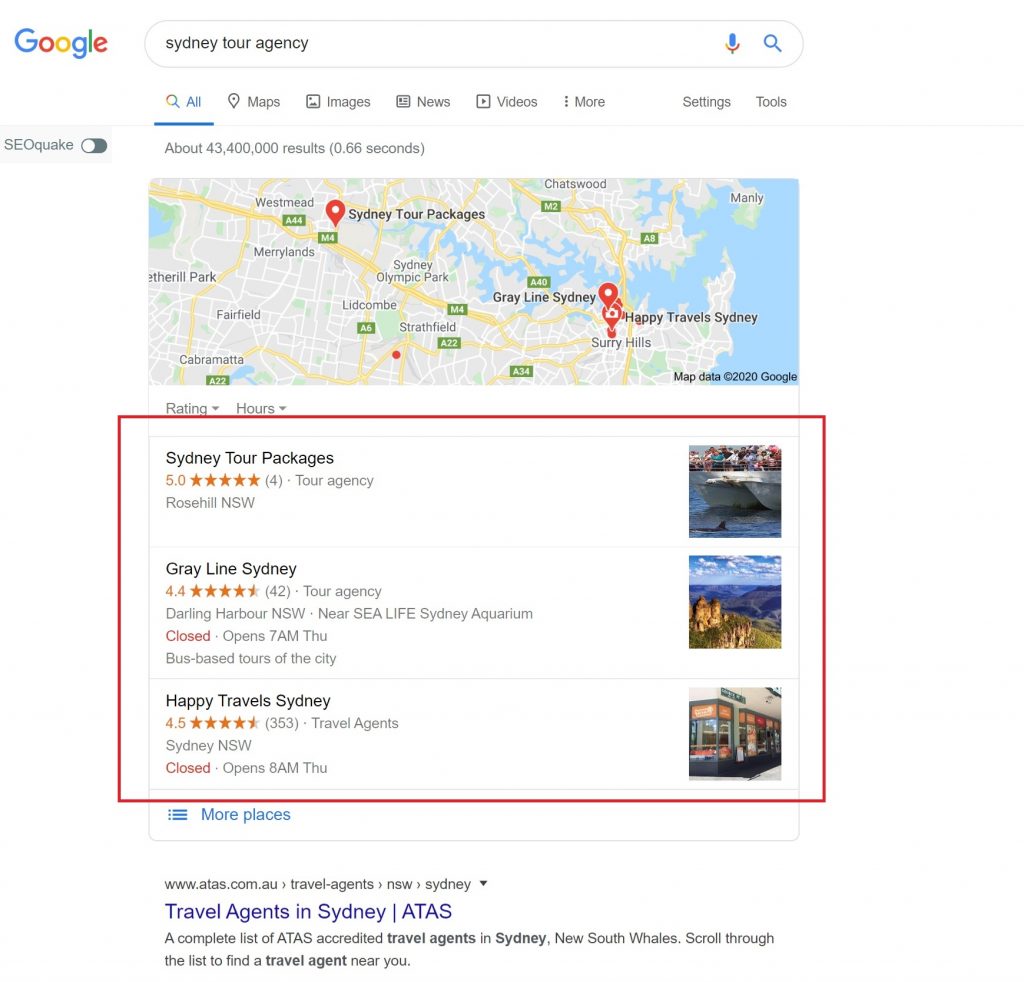
TIPS TO OPTIMISING GOOGLE MY BUSINESS
TIP 1: Complete all relevant information to 100%
Your potential customers are looking for the most complete information before they contact you or make a purchase. Filling out all information to 100% will allow your business to convey that you are indeed the business they’re looking for.
TIP 2: Include all your relevant keywords and search phrases
Treat GMB as its own separate SEO. This means, you must litter all the keywords and search phrases your clients use to search for you on it.
TIP 3: Review all your reviews and address negative ones
Promote reviews with a saved Google My Business link and address negative reviews will go a long way to gaining a customer’s trust and business.
TIP 4 : Curate your company image with high quality photos of your business, culture and products and services
The more photos you have, the higher the click through rate. According to Google, businesses with high quality photos generate twice as much interest as those without.
TIP 5: Add Request a Quote button
Google My Business allows your customers to text you directly on their phones. In order to get a Request A Quote button you must download the Google My Business app on the Google Play or Apple App Store and allow messages.
This allows your potential customers and you to quickly communicate with each other. However, the drawback is you do everything via Google instead of directing your potential customer to your website.
TIP 6: Regularly update posts with content, promotions and events
A website with regular updates sends a signal to search engines such as Google, Bing and Yahoo that it’s fresh and has a higher chance of ranking for more keywords. If you keep this up regularly, you’ll find that after a while, you don’t have to do any other marketing effort at all and still have customers contacting you!
TIP 7: Take advantage of the Q&A section to answer common asked questions
The Questions and Answers section is not limited to your customers! Control the narrative and your showcase your business’s unique value proposition through carefully thought out questions and answers.
TIP 8 : Monitor, track and take advantage of Google My Business Insights
Google My Business Insights can help you understand how your customers find you online and what action they took once they have. It is a valuable analytics tool to have to monitor and improve campaign performance over time.
LEVERAGE POPULAR LOCATIONS AND ATTRACTIONS
If location is one of the most single most important factors when optimising for tours, then attraction would be a close second.
Take for instance, you want to rank for a little known attraction in an unknown area next to Sydney. Not many people are going to search for your tours so it makes sense to leverage Sydney or a more famous attraction (such as the Sydney Opera House) within the area to draw them in.
You will create pages with titles and headings such as Things to do around the Opera House, Things to do outside Sydney, or Top 10 day trips from Sydney etc…
CHOOSE THE RIGHT KEYWORDS
Choosing the correct keywords has always been a fundamental part of every SEO marketing campaign and it is no different for tourism SEO and tourist operators.
While search intent plays a more prominent role in SEO now, keywords are still important.
Place yourself in your customers’ shoes and identify the keywords they use to search for your business then place them strategically throughout your website in articles, website pages and blogs.
There are many keyword research tools with different features and purposes. Below are some of the most popular:
Google Keyword Planner
This popular keyword research tool from Google allows you to find (fairly) accurate numbers of searches per month and generates a large number of keywords based on your website. You can search by website URL and keywords.
Answer the Public
If you want questions relating to who, what, why, where, how, which, when, are, and is of a subject, Answer the Public is your best friend.
Google Trends
Want to quickly see the monthly views between ‘sydney tours’ and ‘blue mountain tours’ or which months the keywords get the most searches?
This is a great tool to use especially if you are a tour operator or run a tour company since a lot of your attractions and destinations may be seasonal.
Keyword Sheeter
If you want a lot of popular keyword ideas fast from Google autocomplete, keyword sheeter will help you achieve this task.
Manual Search Engine ( Google, Bing, Yahoo etc…) research
A manual search engine research may be onerous but it can still be useful if you’re after popular related keywords and search terms that other users search for. Keep in mind that Google’s People Also Ask section has to be in question form and be popular enough for it to be picked up.
*Tip – If you continue to expand on each question, Google will continually add more questions to the existing ones!
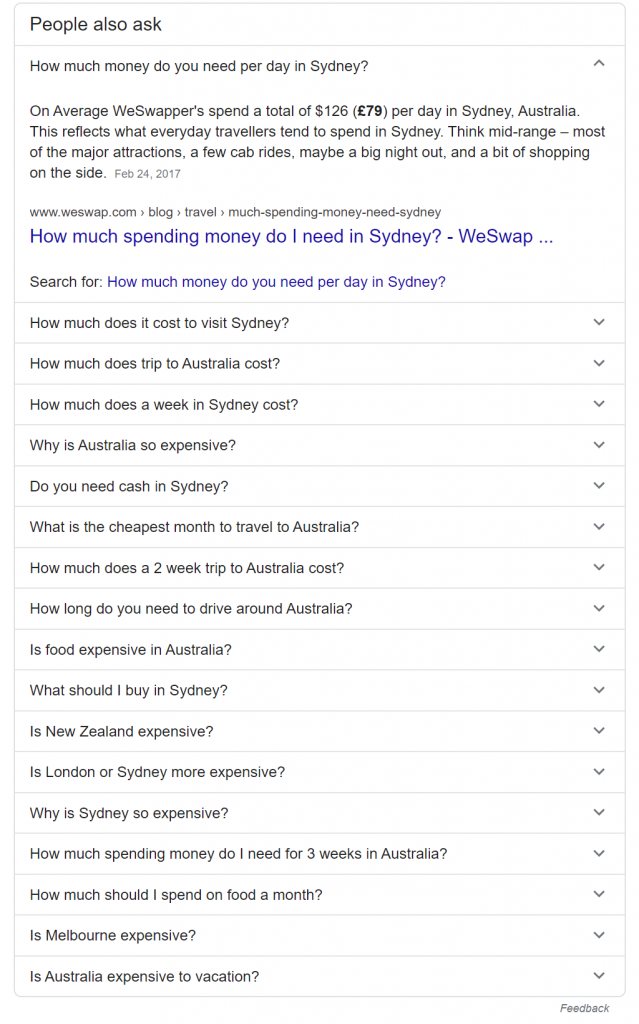
Google Search Console
Google Search Console has plenty of information to help you optimise your website for the keywords and pages you already rank for.
For that, Google Search Console is used more as an optimisation and campaign tracking tool.
CONTENT, CONTENT, CONTENT
Is content necessary for good SEO? Not always but it is rare to see a high ranking website that isn’t filled with loads of high quality original content.
You see, creating great content serves many purposes, chiefly:
- Building authority
- Link to other sources
- Get links from other sources
- Keep clients coming back
- Obtaining new users
By doing these things, you are constantly signaling to search engines that you are the go-to source and company for your potential customers. You will in time be rewarded with a high ranking.
As such, content creation and content marketing should be a regular habit if you want to see your website rank high and attract inbound customers to you.
Don’t know where to start? Don’t worry, this killer content marketing guide will get you started.
BUILD LINKS FROM LOCAL PARTNERS
Backlinks are hyperlinks from another website to yours and they are one of the most important factors for SEO as they pass valuable PageRank or page value to that page and have the potential to raise your Google rankings over time.
As a tour operator, some of the best ways to create backlinks is to ask your partners since you may already have a working relationship with them. They can include but not limited to:
- Travel agencies
- Hotels
- Travel blogs and forums
- Tourism boards
- Transport companies
- Advertising and marketing partners etc…
Tip: If you can, build DoFollow Links as they pass on the link juice and page rank to your website. Nofollow Links are the opposite. They don’t pass their page rank to other sites but can still be advantageous for popular websites to get a name mention.
Switch to a CMS Website
This is often overlooked, but a CMS web design such as with WordPress allows you to make modifications to the website yourself without programming knowledge. If you don’t have a CMS website, it may be worthwhile to change to allow easy customisation.
If you’re one of the 50% of small businesses that don’t have a website, we recommend strongly that you build one.
WordPress also has Yoast SEO which makes things discussed in this article much easier to implement.
LEVERAGING OTHER PLATFORMS
Finally, as this article focuses mostly on SEO for tour operators and not digital marketing as a whole we have left this section last.
There are a number of platforms that provide visibility and authority to your brand that indirectly affects SEO and your website rankings.
Afterall, the more widespread your website and content is, the higher the chances of people sharing it, linking to it and writing about it.
Below are some of the most common ways to get social mentions and backlinks:
- Social media
- Email marketing
- QR codes
- Online Ads
- Forums
- Guest posting
- Holiday and Travelling websites
- Display Ads
- Communities
- Slideshare
- Youtube
- Medium
- Q&A websites such as Quora and Yahoo Answers
SUMMARY
SEO for tour operators in popular destinations and in outback towns can be used to bring quality foot traffic and online traffic to your business.
With the COVID-19 sweeping across the globe, these are trying times for the tourism industry but that doesn’t mean there’s nothing you can do. Working on your SEO now ensures you get a boost when operations resume and you will find that business will be better than before. Focus on what you can control, leave things you can’t.
*** BEFORE YOU GO – We’d like to thank you for taking the time to read this article. It means a lot to us because sharing ones time is one of the most precious gifts one can give. We put a lot of effort into writing our articles so if you enjoyed our article or got something out of it, we would appreciate that you spread the love and share this article or better yet, subscribe to our newsletter below for infrequent, no BS, in-depth articles on how to grow your business online.
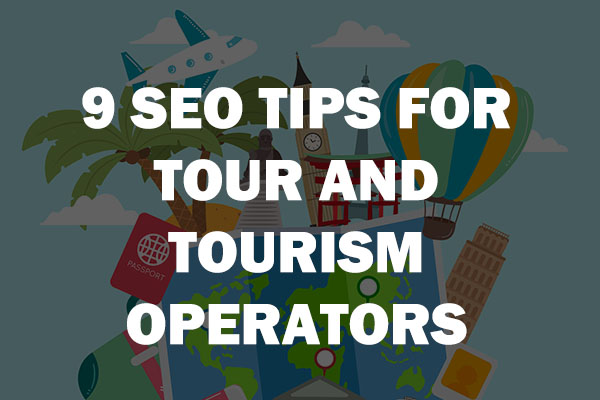
Thanks for this insightful article during these tough times.
Comments are closed.